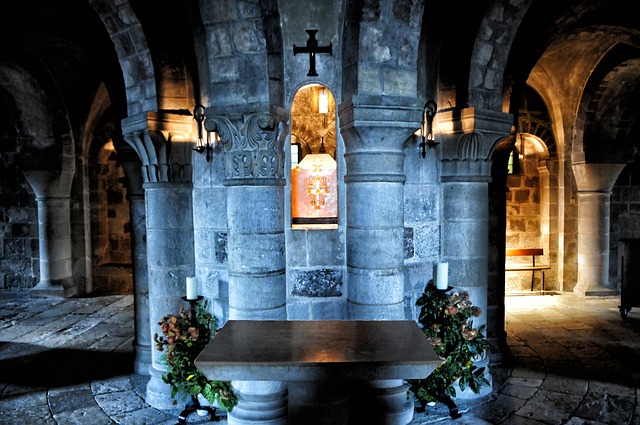Crypt

|
A crypt (from the Greek ‘krypto’, which means hidden or concealed) is a vaulted room frequently made of stone and located beneath a building, usually a church or cathedral. Crypts can also be found in cemeteries, mausolea and chapels, as well as public buildings.
A crypt may be entirely or partly below ground. Occasionally, a crypt may be located at ground level, which would result in the entire building being raised.
Crypts may also be referred to as crofts or undercrofts, however, a croft under a house is not usually called a crypt, which over the centuries has taken more of a religious significance.
When under a church, crypts are usually contained within the limits of the choir or chancel and its aisles, but may be smaller in their subterranean extent, typically confined to just under the altar or the main apse.
The decoration and majesty that is often observed in churches and cathedrals is not usually carried through to the crypt, which is often executed in a much plainer style but nevertheless still well constructed.
Crypts originally emerged as part of French Romanesque architecture in the middle of the eighth century and then spread across much of Western Europe.
In the UK, crypts were often used as chapels and contained an altar and other necessary accessories required for the celebration of feasts. Sometimes, a crypt might be used to allow pilgrims a glimpse of a saint’s tomb or other holy remains and relics. Later, crypts were used more to contain the coffins of the deceased.
[edit] Related articles on Designing Buildings
IHBC NewsBlog
Images from inside a Grade II listed hotel show the scale of its collapse
The Corbett Arms in Tywyn has fallen into serious disrepair.
Old Sarum fire in listed (& disputed) WW1 Hangar - Wiltshire Council has sought legal advice after fire engulfed a listed First World War hangar that was embroiled in a lengthy planning dispute.
UK Antarctic Heritage Trust launches ‘Virtual Visit’ website area
The Trust calls on people to 'Immerse yourself in our heritage – Making Antarctica Accessible'
Southend Council pledge to force Kursaal owners to maintain building
The Council has pledged to use ‘every tool in the toolbox’ if urgent repairs are not carried out.
HE’s Research Magazine publishes a major study of the heritage of England’s suburbs
The article traces the long evolution of an internal programme to research 200 years of suburban growth
IHBC Context 183 Wellbeing and Heritage published
The issue explores issues at the intersection of heritage and wellbeing.
SAVE celebrates 50 years of campaigning 1975-2025
SAVE Britain’s Heritage has announced events across the country to celebrate bringing new life to remarkable buildings.
IHBC Annual School 2025 - Shrewsbury 12-14 June
Themed Heritage in Context – Value: Plan: Change, join in-person or online.
200th Anniversary Celebration of the Modern Railway Planned
The Stockton & Darlington Railway opened on September 27, 1825.
Competence Framework Launched for Sustainability in the Built Environment
The Construction Industry Council (CIC) and the Edge have jointly published the framework.













